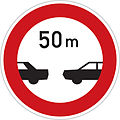VII-1a Route indicator with direction via expressway-ring road (single destination) (old)
VII-1b Route indicator with direction via expressway-ring road (two destinations) (old)
VII-1c Route indicator with direction via expressway (single destination) (old)
VII-1d Route indicator with direction via expressway (two destinations) (old)
VII-2a Route indicator with direction via road for motor vehicles
VII-2b Route indicator with direction via road for motor vehicles (two destination) (old)
VII-2c Route indicator with direction via road for motor vehicles (single destination) (old)
VII-2d Route indicator with direction via road for motor vehicles (two destinations) (old)
VII-3a Route indicator (single destination)
VII-3b Route indicator (two destinations)
VII-3c Route indicator (single destination)
VII-3d Route indicator (two destinations)
VII-4a Local route indicator (single destination)
VII-4b Local route indicator (two destinations)
VII-4c Local route indicator (single destination)
VII-4d Local route indicator (two destinations)
VII-5 Route indicator to specific destination (airport)
Advance sign for junction
Advance sign for roundabout
Advance sign for restriction
Route indicator avoiding restriction
Route indicator avoiding restricted turn
Signboard – change of driving direction
Signboard – change of driving direction
Signboard – change direction
Signboard – change of driving direction with indicated restriction
Advance sign for route avoiding restriction
Diverted traffic for indicated destination
Diverted traffic
Diverted traffic for indicated route
VII-24a
Community (speed limit 50 km/h implied)
VII-25a
End of community (speed limit 90 km/h implied)
VII-24b
Built-up area
VII-25b
End of built-up area
VII-24c
Community (in other language)
VII-25c
End of Community (in other language)
Route confirmation near destination
Regional border
Worded sign (name of a river the road crosses)
Worded sign (name of a tunnel, length 2000 m)
Highway (D5)
Highway (D46)
I class road (or expressway while marked)
I class road (or expressway while marked)
II class road
milestone ("kilometrestone")
milestone ("kilometrestone"); nearest
emergency phone ahead
Route indicator for cycles (two destinations)
Route indicator for cycles (single destination)
Route indicator for cycles (two destinations)
Advance sign for crossing for cycles
Cycle route (16)
Cycle route (3)
Street name
Cultural or tourist destination
Direction to cultural or tourist destination
Distance and direction to cultural or tourist destination
Distance to motorway exit (300 metres)
Distance to motorway exit (200 metres)
Distance to motorway exit (100 metres)

























































































































































































































































